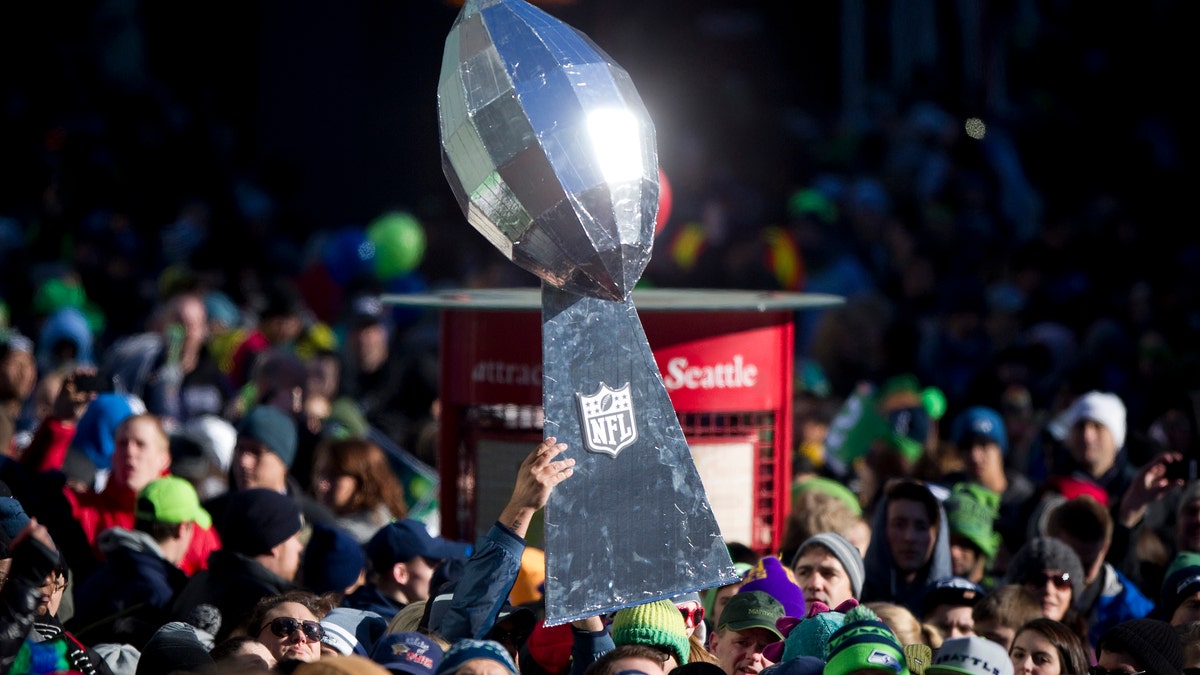
A Seattle Seahawks fan holds a giant Lombardi Trophy Super Bowl during the NFL team's Super Bowl victory parade in Seattle, Washington Feb. 5, 2014. (REUTERS/Ben Nelms)
I'm not very pumped about “deflate-gate.” But I am keen on seeing the Super Bowl on a big screen TV.
It's become something of an annual second Christmas for consumer electronics stores as football fans upgrade their home viewing gear in time for the big game each year. This year, shoppers face a challenging question: Is it finally time to buy a 4K TV?
The game will be televised, of course, but not in Ultra HD, a.k.a., 4K. Ultra HD is the industry brand name for the next generation of sets that offer four times the number of picture elements, or pixels, of conventional high-definition sets. So while HD sets have 1,920 by 1,080 pixels, 4K displays have 3,840 by 2,160 pixels (I know, it's not quite 4,000, but it's close enough).
So why would anyone pay more for a set for which there is no broadcast TV programming (and which won't likely see much content for several years to come)?
The first reason is that 4K sets upconvert (or upscale) standard television and DVD content to Ultra HD resolution in an attempt to sharpen the image. The video processing involved isn't perfect, and the quality of such upconversion varies from set to set, but in general it can improve the picture you receive now.
The second reason is that 4K shows are coming, albeit slowly, not from television networks but rather from streaming services. Netflix already offers some series like the second season of “House of Cards,” and a few movies, such as “Ghostbusters,” in 4K. Amazon Prime is also trying out the format, and Sony is selling downloadable movies in the format.
The third reason is that the TV industry is moving to Ultra HD. This April, when the new crop of sets start appearing in stores, all the top models will be Ultra HD TVs. So, to avoid obsolescence, now may be the time to move up to a 4K set.
I don't recommend the bargain-priced Ultra HD sets currently on the market; they have so many flaws that you're better off buying a standard HD set for less than $500. If you're going for an Ultra HD set, you'll have to pay about $2,000 to get an above-average model that's 55-inches or larger.
Samsung's 60-inch UN60HU8500 is an excellent 4K set and is priced around $2,200. It's an LCD TV with very good black levels that serve it well in rendering dark, spooky movies. It also boasts accurate color fidelity and less motion blur, making it ideal for football and tennis (for the Australian Open this week). The set is also a "smart TV," meaning that it can connect to the Internet and comes with a welter of apps from Netflix and Vudu to Facebook and Twitter.
Another comparably-priced option is the even bigger 65-inch LG 65UB9500. This 4K set is available for about $2,300. Probably the best reason to consider this LG model is that it does a good job upconverting standard HD to Ultra HD. It also boasts LG's new smart TV interface, WebOS, which makes it easier and faster for viewers to find streaming entertainment.
If money is no object -- or at least an object of minimal concern -- then consider the 65-inch Sony XBR-65X950B. It may do the best job upconverting HD programs to Ultra HD, noticeably improving the picture to my eye. Colors, contrast, brightness -- all are top-notch. The price, even with recent reductions, alas, is around $6,000.
Finally, if you're wondering about curved sets, I think of them as deflated balls. Some people may prefer them, but the picture certainly doesn't measure up to the regulations.
